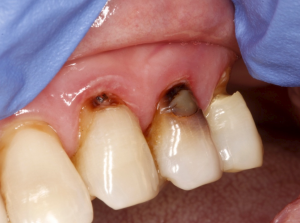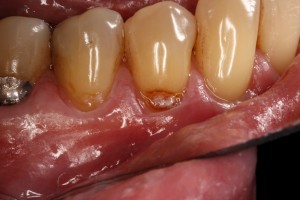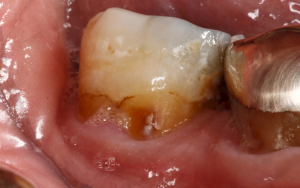Tooth decay on the root surface of teeth may also be called root cavities, root decay, or root caries. It is a potentially detrimental oral health problem that needs immediate treatment to prevent severe dental damage. In this blog, you can learn more about what root decay is, why it happens, how it’s connected to gum disease and soft tissue recession, and what treatments are available to repair your teeth and soft tissue. If you’re concerned you have decay on your tooth’s root surface, contact your dentist in Greenbelt, MD as soon as possible to begin repairs.
Tooth Decay on Root Surfaces

Root caries on lateral incisor, canine and first bicuspid
While many people are fortunate enough to have tough tooth enamel that is seemingly cavity resistant, few people have cavity resistant root surfaces. The root surface does not have a hard, protective enamel covering that is as thick and durable as the crown of the tooth. When gums recede below the enamel line or pull away from the tooth, the root surface is exposed. This unprotected tooth structure is much thinner and more vulnerable to tooth decay. Root caries can only occur if the root of the tooth is exposed through gum tissue recession or loss of attachment between the gum tissue and the tooth roots. The spaces between teeth and gum tissue are called the periodontal pockets, and healthy pockets are shallow and sit close to the tooth. When the periodontal pocket depths increase, it allows teeth to shift and bacteria and plaque to accumulate between the teeth and gums. This can lead to gum disease, root caries, tooth abscess, and a number of other oral health concerns. Gum tissue recession and increased periodontal pocket depth typical occur due to untreated gum disease.
Causes of Root Caries & Gum Recession
There are many reasons you may experience root caries or gum tissue recession. Some of the most common include:
- Poor oral hygiene – not brushing teeth and flossing teeth daily.
Aggressive brushing – brushing teeth too vigorously or using a hard bristled toothbrush. - Age – as people age, their gums typically recede exposing root surfaces.
Periodontal disease – also known as gum disease, this oral health concern increases the depth of periodontal pockets and leads to soft tissue recession, giving plaque and bacteria access to tooth roots. - Genetics – periodontal disease, age-related gum recession, and weak tooth enamel often run in families.
- Diabetes – can weaken the immune system and increase soft tissue inflammation, leading to more severe and difficult to treat gum disease and soft tissue recession.
- Crooked teeth – misaligned teeth are more difficult to clean thoroughly and can increase your risk for gum disease.
- Tobacco use – smoking cigarettes or cigars, dipping, using chewing tobacco, or any kind of tobacco use can damage teeth, weaken enamel, cause try mouth, and increase risk for gum disease.
- Medications – many over the counter and prescription medications are known to cause dry mouth, which increases risk for all types of oral health concerns, including gum disease and caries.
- Trauma – injury to gums or teeth can allow bacteria to accumulate within cracks in the tooth, causing them to grow larger and spread below the gum line.
Symptoms of Root Decay
In some cases, patients don’t have symptoms at all related to root decay. In other cases, patients may experience a range of symptoms, including:
- An exposed root surface frequently becomes sensitive to heat, cold, and sweet foods and drinks.
- You may experience a dull, constant toothache or more severe, sharp tooth pain in the affected area.
- Pain when chewing.
- Swelling or redness in the gum tissue around one tooth.
- Tooth that feels loose.
- Break or crack in tooth enamel.
- Discoloration in tooth enamel.
- Gum tissue recession.
- Infection or sores in the gum tissue around the affected tooth.
Treatments for Root Caries & Gum Recession
The appropriate treatment of receding gums and root caries depends on the reason for soft tissue recession and the extent and severity of the tooth decay. Some of the most common treatments recommended for decay in tooth roots and gum recession include:
- Periodontal Therapy – if the gum recession is caused by periodontal disease, the patient will need periodontal treatment from a dental hygienist, which usually starts with scaling and root planning. Plaque and tartar are removed from the surfaces of the tooth’s root. Periodontal treatment can help gum tissues heal and reattach to the tooth surface.
- Surgical Grafting – If gum recession is advanced, a gum graft where the gum tissue has receded may be indicated. Grafts may help protect the root surface from sensitivity and further decay.
- Dental Restoration – If tooth decay or root caries are present, the patient will need to have the decay removed and replaced with a filling or dental crown. At McCarl Dental Group, we have not used amalgam fillings for more than 25 years. Instead, we use tooth-colored, composite filling material to fill a cavity after removing tooth decay. Dental fillings should not be visible when you smile or talk. We also provide dental crowns crafted from porcelain and other tooth-colored materials.

Tooth colored fillings can repair this root caries before it becomes too advanced

Root caries on a lower molar
- Antibiotics – we may use oral and/or topical antibiotics to treat infection in the gum tissue and tooth abscess. Antibiotic treatment may also be an essential part of the periodontal therapy process to reduce the amount of oral bacteria that produce acidic plaque that can cause damage to soft tissue as well as weakening or decaying the enamel.
- Root Canal Therapy – when decay on tooth roots reaches the interior of the tooth (the pulp), where the tooth’s nerve is housed, we may need to perform a root canal to remove the damaged dental pulp and save the tooth from extraction.
- Tooth Extraction & Replacement – if a tooth can’t be repaired, due to extensive damage from root caries, we may need to recommend dental extraction and tooth replacement. We’ll always do our utmost to save your natural teeth, but we offer a variety of tooth replacement solutions to ensure your smile is complete and functions perfectly.
- Improved Preventive Care – no matter what treatment plan we recommend to address gum tissue recession and cavities on the tooth roots, an excellent oral hygiene routine at home, regular teeth cleanings by a dental hygienist, and dental examinations every six months with your dentist are essential parts of ongoing maintenance. Our dental hygienists teach dentistry patients how to brush and floss teeth in order to clean tooth surfaces and gums thoroughly and prevent further gum recession. This will not repair existing damage, but it will, hopefully, prevent additional gum recession.
Frequently Asked Questions About Root Caries
Below, we’ve included the answers to some of the questions we hear from patients most often after they find out they have a root cavity that needs to be treated. If you don’t see the answer to your question here, we’re happy to talk about it in the office during a consultation or if you give our dental team a call, so don’t hesitate to reach out.
What Happens if I do Nothing?
Oral health concerns are insidious, which means that, without appropriate treatment, they are likely to become more serious over time. Many people think that, if they wait, oral health issues will clear up on their own. This is simply not the case. Instead of clearing up, a cavity on your tooth root will get larger, spread deeper into the tooth, start impacting surrounding teeth, and it can even lead to whole body health issues stemming from the untreated infection. It’s essential to treat cavities and gum disease in early stages to avoid unnecessary oral health issues.
Is Tooth Decay on Tooth Roots the Same as a Dental Abscess?
These are actually two different oral health concerns, but the two may be related. Decay on the tooth roots may lead to infection in the surrounding tissue called an abscess. Tooth abscesses can also occur due to untreated gum disease, tooth damage, or a weakened dental restoration that allows plaque and bacteria to accumulate. Tooth abscesses are very painful, and they can cause a number of oral and overall health concerns without treatment.
Do I Need Gum Disease Treatment & Cavity Treatment?
If your tooth root decay happened due to soft tissue recession as a result of untreated gum disease, it’s essential to treat both the cavity and the periodontal disease to ensure your oral health is fully restored. Without treatment for both, you are still at risk for developing root caries in the future.
Do I Need a Root Canal?
Root canal therapy is necessary only if the tooth decay reaches the innermost layer of the tooth called the pulp where the tooth’s nerve is housed. When this happens, we can perform a root canal to remove the damaged pulp tissue and refill the tooth with a biocompatible substance. This procedure has a bad reputation, but in many cases, it’s the only way to save a severely damaged or decayed tooth from extraction.
Will I Need to Have My Tooth Extracted?
In some cases, tooth extraction is necessary. However, we will do our utmost to retain your natural teeth, including removing decay, performing root canal therapy, treating gum disease, and even placing soft tissue grafts when necessary. If we do need to extract your tooth, despite our best efforts, we will partner with you to plan for tooth replacement as part of your treatment process, so you’ll have a full, healthy smile again as soon as possible.
Meet the McCarl Dental Group Team
Do you still have some questions about tooth root decay or gum tissue recession that weren’t answered here? The McCarl Dental Group team would be happy to help you. With more than nine decades offering dentistry services for Greenbelt, MD dental patients, our dentists and dental team have treated generations of family in our community. Their knowledge, expertise, and genuine determination to help Greenbelt families smile make McCarl Dental Group the go-to dental office for all of your dentistry needs in one convenient location.
